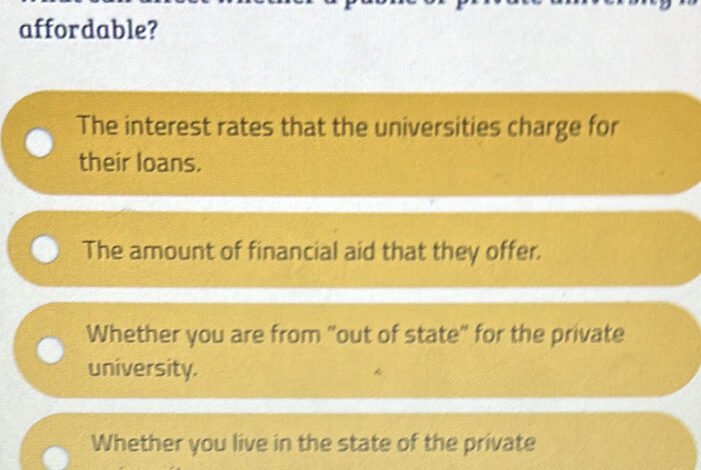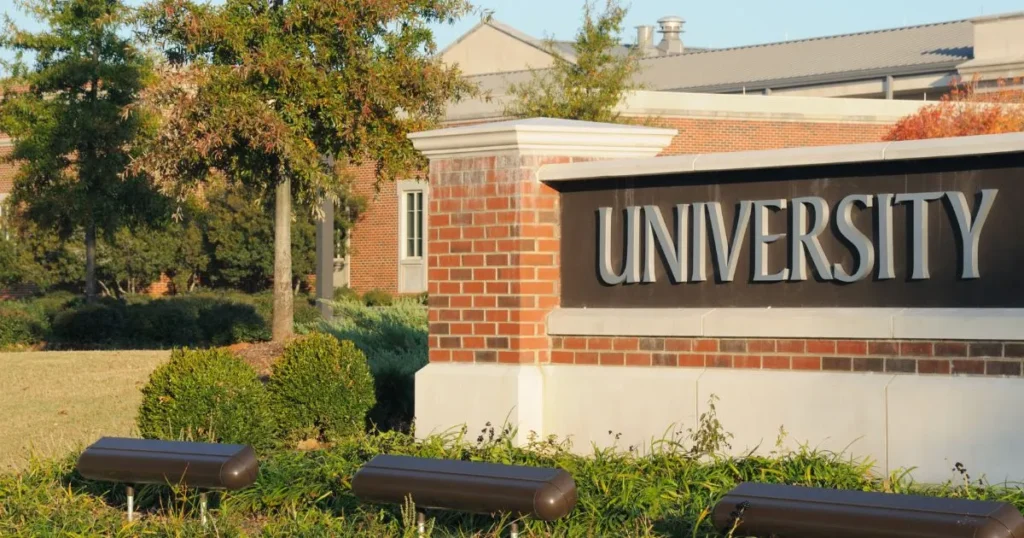What Can Affect Whether A Public Or Private University Is Affordable: Key Factors

Affordability of public and private universities varies. Several factors influence this.
Choosing between public and private universities often hinges on cost. Understanding what makes a university affordable is crucial for students and families. Tuition fees, scholarships, living costs, and financial aid all play roles. These factors can differ greatly between public and private institutions.
Knowing how they impact affordability can help you make an informed decision. Dive into the details to see what makes a university truly affordable for you.

Credit: www.ncan.org
Tuition Fees
Tuition fees are a significant factor in determining whether a public or private university is affordable. These fees can vary greatly based on several factors, including whether the institution is public or private and the student’s residency status.
In-state Vs Out-of-state
Public universities often have different tuition rates for in-state and out-of-state students. In-state students typically benefit from lower tuition fees because they or their families pay state taxes. Out-of-state students usually face higher tuition fees. This is because they do not contribute to the state’s tax base.
For example, at a public university:
| Student Type | Annual Tuition Fee |
|---|---|
| In-state | $10,000 |
| Out-of-state | $30,000 |
Private University Costs
Private universities do not differentiate between in-state and out-of-state students. They charge the same tuition fees for all students. These fees are often higher compared to public universities. This is because private universities do not receive state funding.
For example, a private university might charge:
| Student Type | Annual Tuition Fee |
|---|---|
| All Students | $50,000 |
While tuition fees at private universities are higher, they often offer significant financial aid packages. These can help reduce the actual cost for many students. It is important to consider both the sticker price and the potential financial aid when evaluating affordability.

Credit: laptopspapa.com
Financial Aid
Financial aid is a crucial factor in determining the affordability of a university. Many students rely on financial assistance to reduce the burden of tuition fees and other expenses. Understanding the different types of financial aid can help you make an informed decision.
Grants And Scholarships
Grants and scholarships are forms of financial aid that do not require repayment. Public and private universities offer a variety of grants based on need or merit. Scholarships often reward academic achievement, sports talents, or other specific criteria. These aids can significantly reduce your overall cost.
Loans And Repayment Plans
Loans are another common form of financial aid. While they must be repaid, they can make education more accessible. Federal loans often have lower interest rates and more flexible repayment options. Many private universities offer tailored repayment plans to ease the financial burden on students.
Location
Location plays a significant role in determining whether a public or private university is affordable. The cost of living and regional price variations can greatly impact a student’s overall expenses. Let’s dive into these factors to understand better.
Living Expenses
Living expenses can vary greatly depending on the university’s location. Cities with a high cost of living, such as New York or San Francisco, may result in higher expenses for students. This includes rent, food, transportation, and other daily necessities. On the other hand, universities in smaller towns or rural areas may offer lower living costs.
Let’s look at some typical living expenses:
- Rent: Urban areas often have higher rent compared to rural regions.
- Food: Grocery and dining costs can be higher in metropolitan areas.
- Transportation: Public transport or fuel costs vary by location.
- Utilities: Electricity, water, and internet costs may differ.
Regional Cost Variations
Regional cost variations also play a crucial role. Different states and regions have different economic conditions. This affects tuition fees, cost of materials, and even job opportunities for part-time work. For example, universities in the Midwest might have lower tuition fees compared to those on the East or West Coast.
Here is a table showing some regional cost variations:
| Region | Average Tuition (Public) | Average Tuition (Private) | Living Expenses |
|---|---|---|---|
| Midwest | $10,000 | $30,000 | $12,000 |
| West Coast | $15,000 | $40,000 | $18,000 |
| East Coast | $20,000 | $45,000 | $20,000 |
As seen in the table, the cost of attending a university can vary significantly by region. Students should consider these variations when deciding on a university.
Institution Type
The type of institution plays a key role in affordability. Public and private universities differ in their funding, costs, and financial aid. This impacts how affordable they are for students.
Public University Funding
Public universities receive state funding, which helps lower tuition costs. This funding is provided by taxpayer money. As a result, in-state students often pay less. Out-of-state students may face higher fees. Public universities also have larger student bodies. This allows for more diverse programs and services.
Private University Endowments
Private universities rely on tuition and private donations. They do not receive state funding. This often results in higher tuition costs. Many private universities have large endowments. These funds can provide substantial financial aid. Scholarships and grants help reduce the overall cost for students. Smaller class sizes and personalized education are other benefits.
Program Duration
Program Duration plays a significant role in the affordability of both public and private universities. The length of the program can directly impact the total cost of education. Let’s delve into how program duration affects overall affordability.
Traditional Vs Accelerated Programs
Traditional programs usually span four years for a bachelor’s degree. These programs often include a broad range of courses. This means you may spend more time and money on subjects not directly related to your major.
Accelerated programs, on the other hand, offer a faster route to graduation. These programs can be completed in as little as two to three years. This quicker pace means fewer years paying tuition, potentially saving you a lot of money.
Impact On Overall Cost
The overall cost of education is influenced by the duration of your program. Here’s a simple comparison:
| Program Type | Duration | Total Tuition Cost |
|---|---|---|
| Traditional | 4 years | $80,000 |
| Accelerated | 2-3 years | $50,000 |
Based on the table above, traditional programs often lead to higher total costs. This is due to longer duration and additional living expenses.
Shorter program durations can also reduce the opportunity cost. This means you can enter the job market faster. Starting your career earlier can lead to quicker income generation, offsetting your educational investment sooner.
In conclusion, the program duration significantly affects university affordability. Whether you choose a traditional or accelerated program can make a big difference in your overall educational expenses.
Campus Amenities
Campus amenities play a crucial role in determining the affordability of a university. They directly impact the cost of living and overall student experience. Let’s explore some key campus amenities that can affect whether a public or private university is affordable.
Housing Options
Housing options significantly influence the cost of attending university. Public universities often provide a variety of on-campus housing choices. These can range from dormitories to apartment-style living. Private universities might offer fewer housing options, which can drive up costs. Off-campus housing can also vary in price depending on location and demand.
Meal Plans
Meal plans are another factor that affects university affordability. Public universities generally offer several meal plan options. These can cater to different dietary needs and budgets. Private universities might have fewer choices, sometimes leading to higher costs. Consider the flexibility and variety of meal plans when evaluating a university’s affordability.
Part-time Vs Full-time Study
Choosing between part-time and full-time study can greatly affect whether a public or private university is affordable. Each option has unique implications for cost, flexibility, and job opportunities. Understanding these differences can help you make an informed decision.
Impact On Tuition
Tuition costs often vary between part-time and full-time study. Full-time students usually pay a flat rate per semester, which covers a set number of credit hours. This can sometimes result in lower costs per credit hour compared to part-time study.
Part-time students typically pay per credit hour. While this can spread out the cost over a longer period, the per-credit fee might be higher. Below is a simple comparison:
| Study Type | Cost Per Credit Hour | Total Cost Per Semester |
|---|---|---|
| Full-time | $300 | $3,600 (12 credits) |
| Part-time | $350 | $1,400 (4 credits) |
Flexibility And Job Opportunities
Flexibility is a significant factor in the affordability of public and private universities. Part-time study offers more flexibility, allowing students to balance work and education. This can be crucial for those who need to earn an income while studying.
Job opportunities are often more accessible to part-time students. They can take advantage of internships, part-time jobs, and other work experiences. These opportunities not only provide income but also valuable experience.
- Part-time study: More flexibility, better work-study balance.
- Full-time study: Faster completion, less time for work.
Considering both tuition impact and flexibility can help you decide which study mode suits your financial and personal needs best.

Credit: www.aplu.org
Employment Rates
Employment rates play a significant role in determining the affordability of a university. High employment rates suggest that graduates can quickly find jobs. This can ease the burden of student loans and other expenses. Both public and private universities strive to offer good employment opportunities. Yet, several factors can influence these rates.
Post-graduation Employment
Post-graduation employment is a crucial factor. Graduates need jobs to repay their loans. Universities with strong employment rates often have robust career services. These services help students prepare for the job market. They offer resume workshops, interview training, and job fairs. Public universities might have larger networks due to more alumni. Private universities often boast personalized career support.
Internship Opportunities
Internship opportunities also affect employment rates. Internships provide real-world experience. They help students build connections in their field. Public universities may partner with large companies due to their size. Private universities might offer exclusive internships with niche firms. Both types of institutions recognize the value of internships. They know internships can lead to job offers.
Frequently Asked Questions
What Factors Influence University Affordability?
University affordability is influenced by tuition fees, available financial aid, and living costs. Public universities often have lower tuition fees.
Is Financial Aid Available For Both Public And Private Universities?
Yes, financial aid is available for both. Public universities typically offer more state-funded aid, while private ones may provide substantial scholarships.
How Do Living Costs Impact University Affordability?
Living costs, including housing, food, and transportation, can significantly impact overall affordability. Urban areas usually have higher living expenses.
Do Tuition Fees Vary Between Public And Private Universities?
Yes, public universities generally have lower tuition fees due to government funding. Private universities often have higher fees.
Conclusion
Affordability of public or private universities depends on various factors. Tuition fees, location, and financial aid options play significant roles. Scholarships and grants can make a big difference. Living expenses also impact overall costs. Research thoroughly before making decisions. Comparing different universities helps you find the best fit.
Remember, education is an investment. Choose wisely. Your future depends on it.



